Stuff I like - A2-16 Ski Poles
 Sunday, June 3, 2018 at 12:34AM
Sunday, June 3, 2018 at 12:34AM 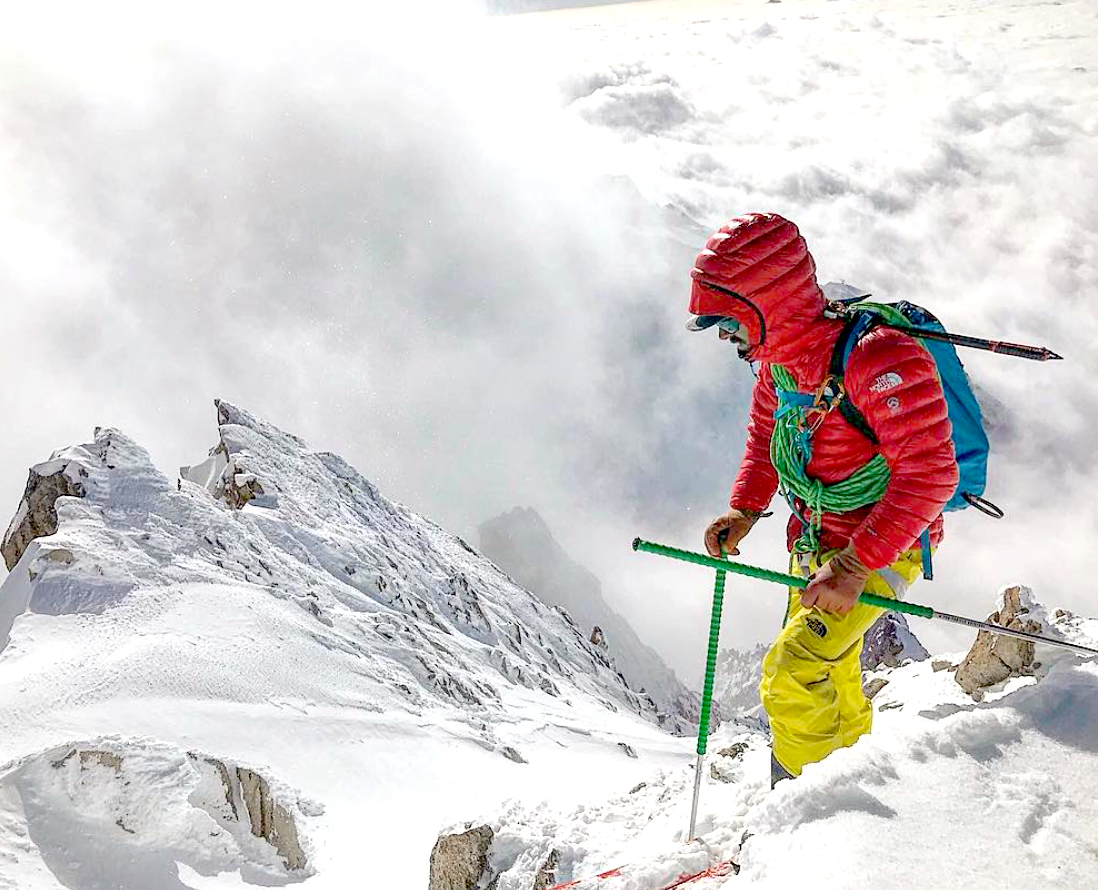 The A2-16 ski pole from Chamonix represents the full pendulum swing of pole design which I feel best suits the need of steep skiers and ski alpinists. My path to them has involved many stops with attempts at several innovations tried and discarded along the way. I’ll present a case for them here along with some history about the journey.
The A2-16 ski pole from Chamonix represents the full pendulum swing of pole design which I feel best suits the need of steep skiers and ski alpinists. My path to them has involved many stops with attempts at several innovations tried and discarded along the way. I’ll present a case for them here along with some history about the journey.
From my earliest days as a teenager learning how to travel in the mountains, I’ve always considered myself a minimalist. Simpler, lighter or just less stuff is my preferred way to approach any outing. This is what attracted me to ski mountaineering racing. The ability to move fast over vast amounts of terrain in winter is directly related to the gear applied to the task. Once I started racing, it didn’t take long for me to start scheming ways to use the same svelte equipment on bigger objectives and ski alpinism.
Adjustables
One piece of equipment that I’ve been messing around with the last several years is the ski pole. Now, most backcountry skiers don’t give poles much thought. One only has to hang out at any popular trailhead in the middle of winter and you’ll see what I mean. It’s a procession of mostly Black Diamond adjustable poles (245 grams with nordic grips). The casual skier tends to be the most industry-inluenced consumer sub group on the skin track. The marketing is effective and the popular poles do the job. Most of these skiers probably don’t use the adjustable feature too often. You simply don’t need it for powder skiing.
I used adjustable poles for years because that was simply what one did as a BC skier in this country. My trekking poles that I used when I was guiding were the same. At one point, I attached nordic grips with biathlon wrist straps to them to make them lighter and easier to plunge into the slope at transitions. But I’ve also had a couple of failures over the years where the poles broke at the joint when I fell on them. I also had one end go sailing down a couloir while hacking at the cornice. I slowly lost my enthusiasm for them.
Black Diamond Whippet
As skiers decide to venture into the realm of ski mountaineering, the next piece of mandatory ski pole regalia is the ubiquitous Whippet (425 grams). Nothing says skimo like one of these. I’ve heard all the arguments for and against these things and they’re well-documented on the internet. I frankly don’t want to deal with the tedium of the commentary here. Although I own two, I haven’t used them in years. When it comes to minimalism in ski poles, the adjustable Whippet is not.
When in France…
Chamonix is the steep skiing epicenter of the universe. My social media feed is filled with the modern practitioners of the discipline. A few years ago I noticed a curious trend with some of my heros where their poles were strapless and sported extra long grips common in Europe. I wondered what that was all about. When I spent a few months in Chamonix in 2014, I got a first hand view of the trend and some of the products that supported it, including the A2-16. Unfortunately, by the time I wrapped my brain around the idea and its implications, the shops were sold out. The next fall, I found a source for the Furtis by Black Crows, another Chamonix based company and promptly ordered them up. The grips are long by American standards but shorter than those found on the A2-16’s.
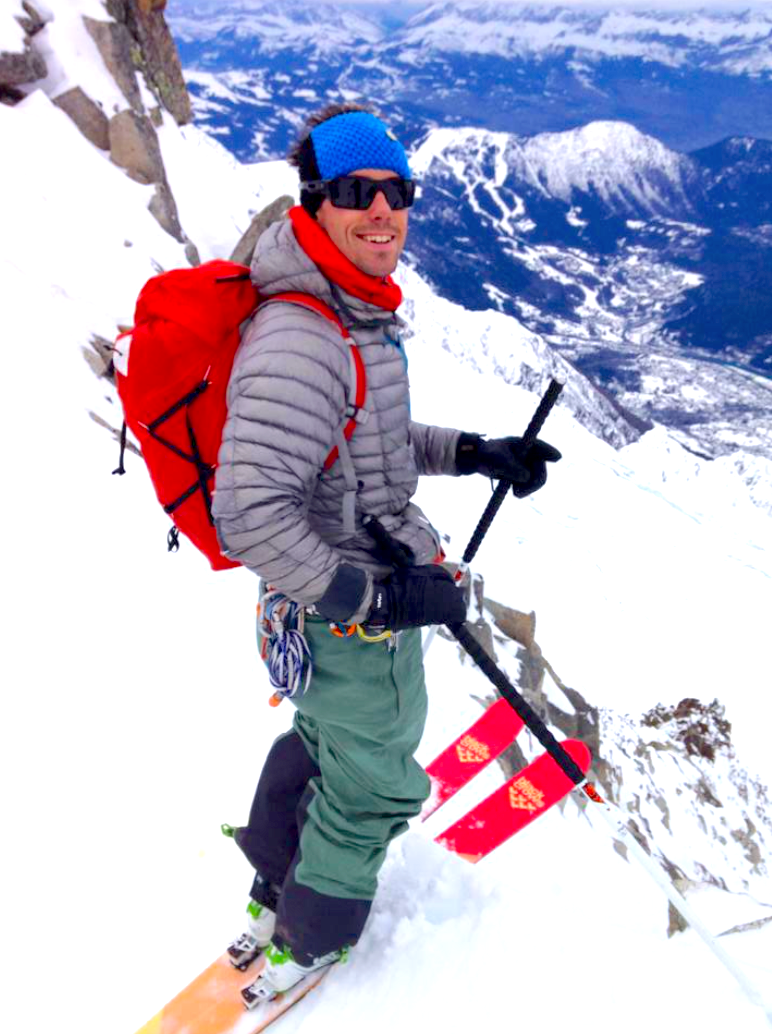 A year later, I was a client on a guided ski tour in the Selkirks. The head guide preferred us to ski without straps so I decided to experiment and take mine off all together. Initially, I thought I’d simply drop the poles unexpectedly in the middle of a run. Curiously, this didn’t happen. What I did feel was a liberation from the minor hassle of dealing with straps. Taking pictures, messing with gear, eating on the run all require some fussing in and out of straps. When they’re gone, so is the fuss. Elegant simplicity.
A year later, I was a client on a guided ski tour in the Selkirks. The head guide preferred us to ski without straps so I decided to experiment and take mine off all together. Initially, I thought I’d simply drop the poles unexpectedly in the middle of a run. Curiously, this didn’t happen. What I did feel was a liberation from the minor hassle of dealing with straps. Taking pictures, messing with gear, eating on the run all require some fussing in and out of straps. When they’re gone, so is the fuss. Elegant simplicity.
Now the argument against this trend is that straps make skinning low angle terrain more efficient allowing longer pole strides and relaxed hands. I can’t argue with that. But once the skin track steepens, most skiers stop using straps and start either choking up on the poles or, if the traverse is long, adjusting the uphill pole to a shorter length. I needed to come up with a way to have the best of both worlds.
Back to the advantages. Certainly, most skiers will admit to the increased safety of skiing without straps in avalanche terrain. It’s hard to argue this point. Poles act like boat anchors for your limbs in the event you find yourself attempting to swim through a slide. I have first hand experience with this. I was not using straps when I got rolled while booting up a steep couloir. I managed to hold onto one pole but never found the second after the dust had settled. But it was easy to imagine what it would be like if my arms were pinned. No bueno.
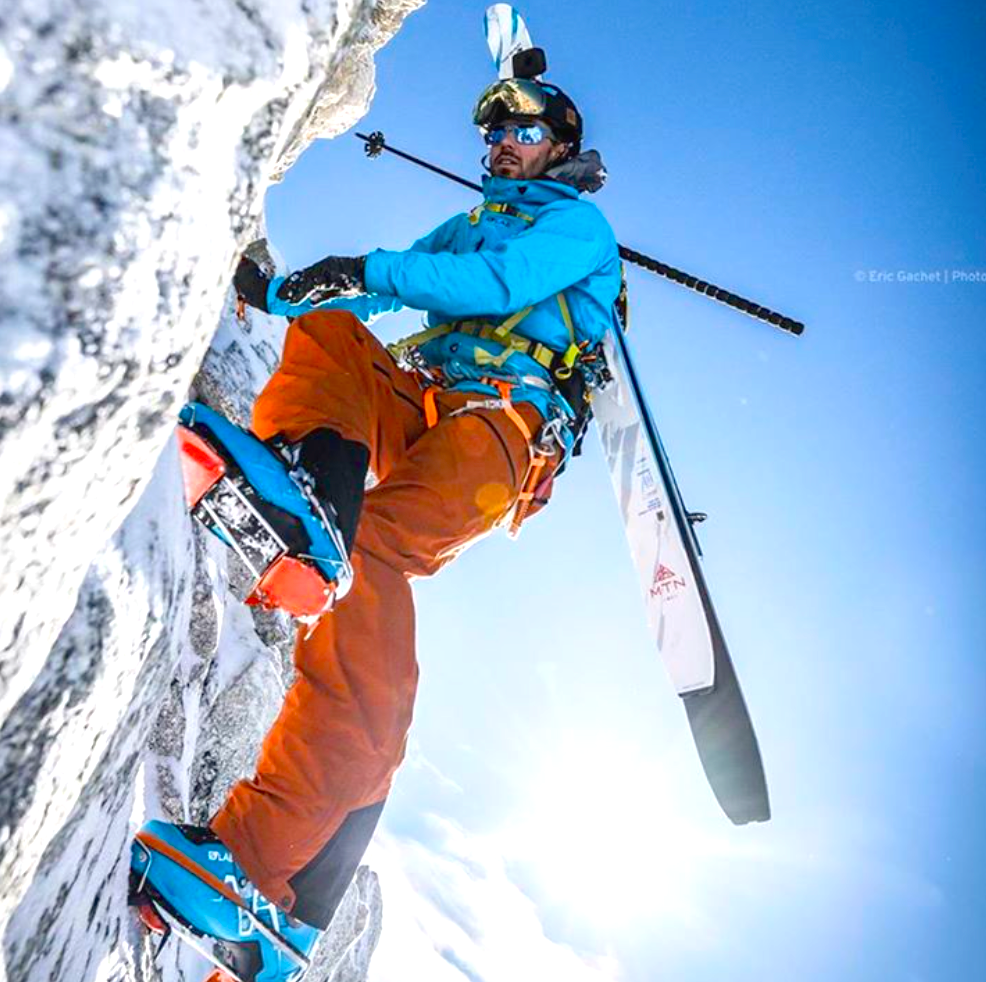 Alex Pittin - ChamonixIn technical terrain, the advantages of traveling strapless multiply. When leap frogging with partners down a steep line, we’re constantly moving in and out of safe zones, taking pictures, assessing the way ahead. Having hands unencumbered makes these transitions simpler and quicker. Without straps, pole handles more easily penetrate the surface, making it easier to stab them into the slope and free your hands to do other tasks. On rappels, poles are easily stashed between your back and the pack and stuffing them there is less fiddly without straps snagging. With long, Euro-style grips, adjusting hand position on the pole shaft becomes easy and advantageous. It’s hard to understand the advantages of hand position flexibility until you try it. This simply isn’t an option with adjustables as the tedium of adjusting limits how often you’ll actually do it. There is also an elegant simplicity and a perceived “lightness” that comes when you eliminate pole straps flying about as you descend.
Alex Pittin - ChamonixIn technical terrain, the advantages of traveling strapless multiply. When leap frogging with partners down a steep line, we’re constantly moving in and out of safe zones, taking pictures, assessing the way ahead. Having hands unencumbered makes these transitions simpler and quicker. Without straps, pole handles more easily penetrate the surface, making it easier to stab them into the slope and free your hands to do other tasks. On rappels, poles are easily stashed between your back and the pack and stuffing them there is less fiddly without straps snagging. With long, Euro-style grips, adjusting hand position on the pole shaft becomes easy and advantageous. It’s hard to understand the advantages of hand position flexibility until you try it. This simply isn’t an option with adjustables as the tedium of adjusting limits how often you’ll actually do it. There is also an elegant simplicity and a perceived “lightness” that comes when you eliminate pole straps flying about as you descend.
The one place I missed straps during my experimenting was on long flat skins in and out of the mountains. Double poling with strapless, straight grips is tedious and hand fatiguing, for sure. This got me thinking about ways to have my cake and eat it too. I wanted a way to take straps on and off easily when I needed them. I experimented with a couple of ideas.
My first pair of longer gripped poles were made by Trab (285 grams). They sported a traditional molded grip with additional foam beneath it for choking up. The grip was contoured enough to support my hand while poling and going strapless didn’t degrade the performance much. On the other hand, the grips came fitted with a removable strap that snapped into place.
The problem was that I needed something sharp to disengage the fitting so I reserved the straps for the exit. The other problem with this set up was that the socket into which the buckle went would clog with ice and snow after plunging the grip end into the snow during stops. Not ideal. I purchased the poles in my usual 125 cm length which is fine for skiing but does not lend the same advantage as lengthening an adjustable to 135 or 140 cm for double poling. The Trap grips are not as long as some in their class so I added some rubber bicycle grip tape further down the shaft and improved their versatility considerably.
My next concept was tried on a pair of straight gripped Black Crows Furtis carbon poles (250 grams).
I wanted to utilize a quick release strap from a nordic design to make on and off easier. As you can see, I used a cotter pin retained with a small cord. This worked well until ice built up in the hole from plunging them into the snow while transitioning. Fail.
All this has led me to my current pole, the A2-16 (205 grams). Grips are extra long and comfy and there's a clever slot at the top for a strap. These are not sold in the U.S. so I had to do some digging on line and writing to the guy who makes them to get a pair. It was a little late in the season by the time I worked out the details involving bank transfers and shipping issues. The process certainly needs to be improved. Additionally, the usual pole chosen, a 16mm diameter shaft, were sold out so I settled for the 14mm ones. Arguably lighter but not as strong, I suppose. They come in a variety of festive grip colors consistent with the trend toward Skittles palates. I ordered my usual length of 125 cm but I was sent 135 cm. Given the hassle and expense of getting them here, I wasn’t about to send them back. After some consideration, however, I decided that the longer length would be ideal when double poling.
One key feature of the poles is the attachment point for a wrist strap. 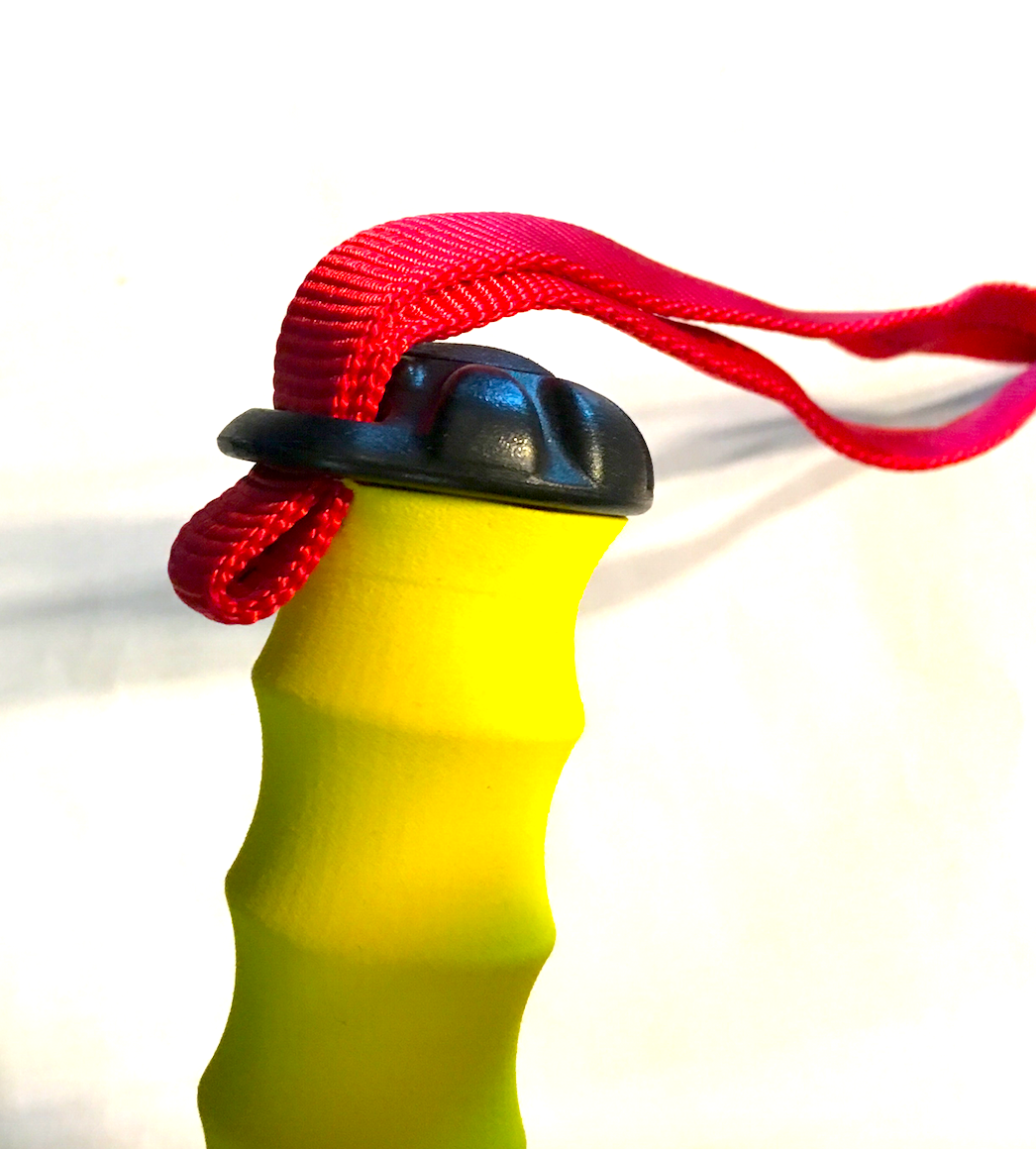
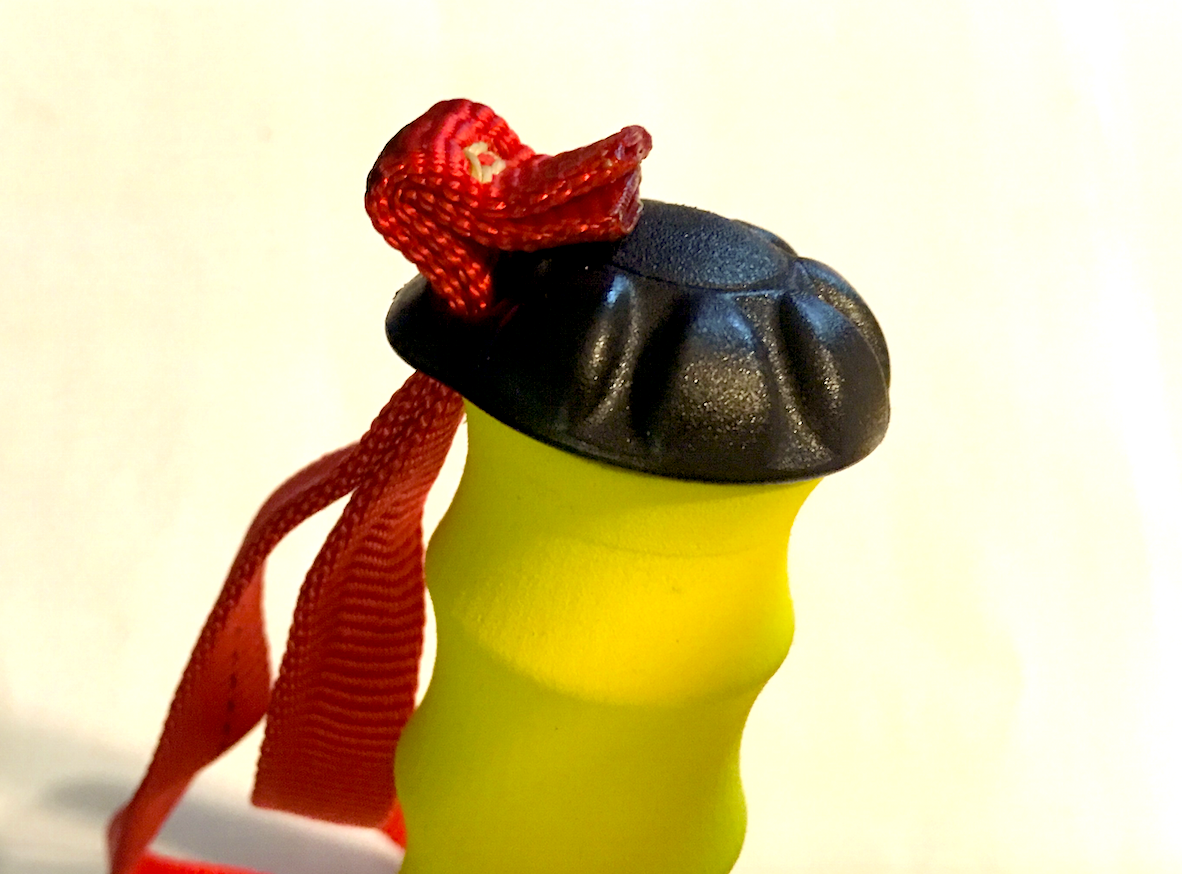
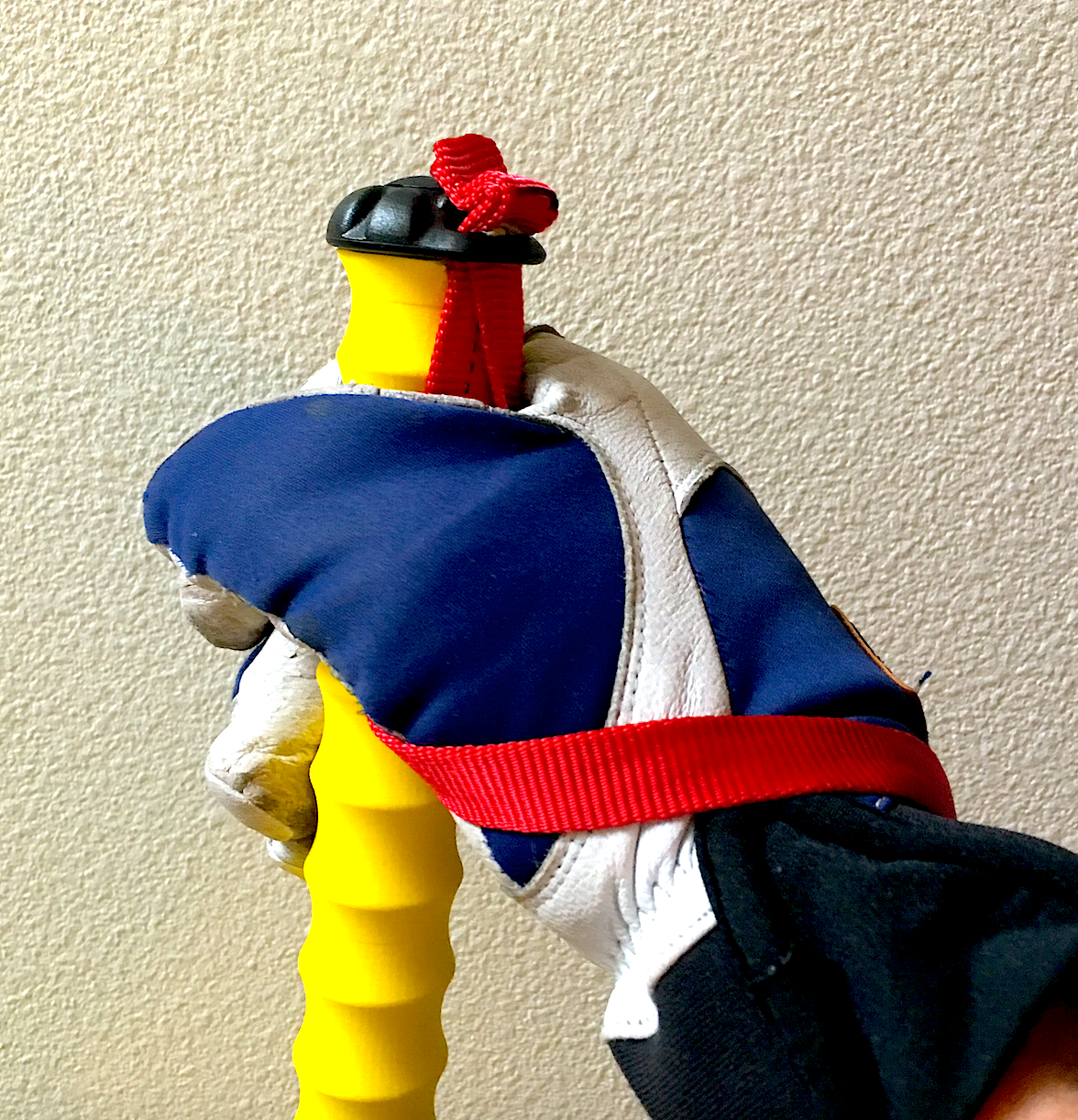 As you can see, I was able to fashion a very light and simple solution for quick on and off that basically solved all my problems (or at least the ones related to ski poles). Sadly, the poles arrived a day or two after I blew my ACL so I’ve not been able to put them to use yet. But I’m confident that they will live up to my expectations. In fact, just the other day, some other A2-16 users came through Anchorage on their way to the great range and I showed them my wrist strap concept. They, too, felt it was a simple solution to the same complaint they had dealt with.
As you can see, I was able to fashion a very light and simple solution for quick on and off that basically solved all my problems (or at least the ones related to ski poles). Sadly, the poles arrived a day or two after I blew my ACL so I’ve not been able to put them to use yet. But I’m confident that they will live up to my expectations. In fact, just the other day, some other A2-16 users came through Anchorage on their way to the great range and I showed them my wrist strap concept. They, too, felt it was a simple solution to the same complaint they had dealt with.
One additional modification that came out of our discussion, this one with Mike Yarno, was to reinforce the distal end of the grip. Mike noticed that after heavy use, the grips, which are actually 3 separate sections of foam glued together and glued to the shaft, can come loose and slide down. He added some tape to his to prevent this and I decided to try some hot glue to the same effect. I’ll report on it’s durability after next season.
 Brian |
Brian |  13 Comments |
13 Comments |  A2-16,
A2-16,  ski poles,
ski poles,  steep skiing in
steep skiing in  Gear
Gear 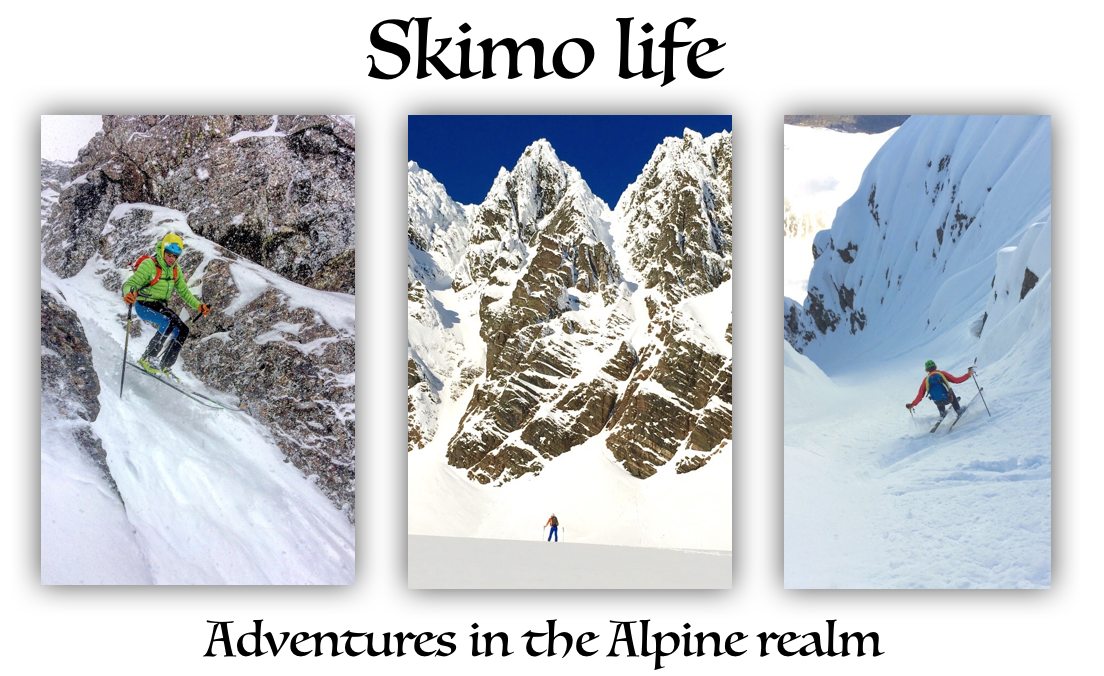



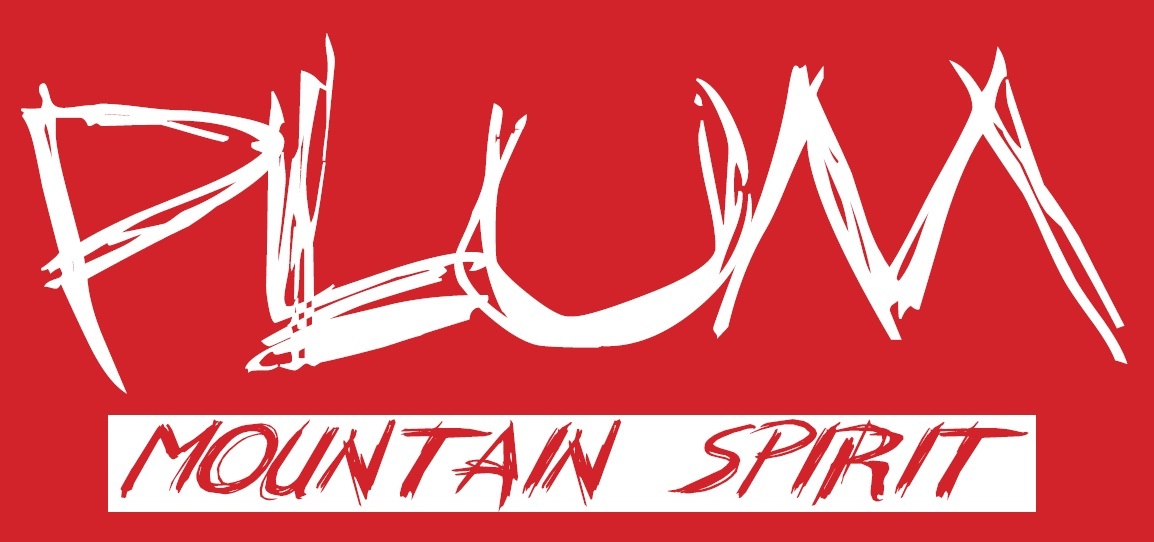

Reader Comments (13)
Your guided me to the Black Crowe Furtis two years ago. Never looked back. Damn good advice and insight. I bailed on the BD adjustables years ago, but ended up going too light and snapped several ski area poles. Fail. I love the "function first" aspect that continues to inform equipment design and choices in this fringe discipline.
Matthew,
You must have been uniquely bored to have visited the site but you came at a good time with some recent activity in the equipment realm. Of course, with my knee injury coinciding with our spring rendezvous, we missed some quality time together to explore all things skimo related at length and in person.
Brian,
Glad to see that ACL rehab hasn't stopped you from thinking about ski season and, as always, tinkering with gear. I've looked at the Furtis pole you recommended in the past, but the extra shaft diameter didn't make much sense unless you have enormous hands. Unfortunately there aren't all that many other fixed-length poles made for a backcountry application. As a seat of the pants solution, I used a pair of Trab Piuma alu race poles, with some friction tape wrapped below the grip for choking up, on consolidated snow this spring (no need for heavy rounded baskets). Worked well, was light and didn't bend much, the bending being my main gripe w/ BD poles. As a former nordie I'll never get rid of my straps. I'm not even sure how I'd get uphill without them. Then again, if strap-less poles are good enough for Arno/Killgore/Holmes they should be good enough for the rest of us!
What's the logic behind 125cm poles for a guy of your height? Do you ever run out of pole on flatter skintracks?
Hope recovery is coming along, I was digging the "Blown" series and would be psyched to read some followups as you're getting back to the mountains.
Scott,
Are you kidding? I'm pretty much thinking of skiing every day, most hours, if not minutes. Yep, major problem.
To be honest, many good alpine skiers have accused me of using poles that are TOO LONG at 125cm. Go figure. Obviously, your history of Nordic racing makes you prone to embracing longer poles. I used them, as well, when I was racing skimo but the longer length is a pain for technical stuff unless you choke up. Your observations about longer flat skins is spot on and is why I'm cool with the 135 cm that I have now with the strap mod. I'm sure you'd prefer 145 cm but the difference is only going to be a minute or two on most of my longer exits so I'm okay with that.
You're right about the big grips on the Furtis. They're pretty fat but I never noticed an issue. I have bigger than average mitts. As an aside, a friend who got a pair had him break in his ski bag when traveling by air. I thought they were indestructible. The Black Crows Oxus pole is a narrower alu version that might suit you. I have a pair and like them. But the strap mod is less elegant than what I can do with the A2-16. Of course, we're going to have to wait for bit before I can put them through the wringer.
Brian
Couldn't resist commenting. I made the mistake of getting Black Diamonded up before my first season in Chamonix. About 2 months in I snapped one in an undignified pile up. When considering replacing the broken one I realised I had never once adjusted them. So I bought some Dynafit Manaslu with a peculiar long handle. I loved them and they saw me through to near the end of my 3rd season. By that time the aluminium shafts had been bent and straightened more than a few times due to mishaps (see a trend...?) and they looked ready to snap any time. I read your review of the Furtis and found a pair in the end of season sales. Very smart and well made.
Using them early last season I quickly found that the handle just didn't agree with me. I wouldn't have thought that it could have made that much of a difference. The A2-16's feel much more natural, but were sold out in my length. So I compromised with some Sweetsticks. Pseudo longer handle, zebra coloured and economical. What's not to like. Perhaps the A2-16's this winter....
I owe you a belated thanks following your 2014 Chamonix reports. I noted where you stayed. This winter will be my 5th season staying in René's place in Les Pelerins.
Richard,
Those are good stories and glad you found Rene. Good dude and nice digs, for sure. I love the bakery and store just down the hill.
I agree with you on the handles of the BC pole. They hold up but fatigue my hand. I think the A16 will be better. The one caveat I'll share about them that comes from experienced users is that the handle can work loose after heavy use. You can add a bead of hot glue at the handle/shaft interface that would likely reduce the occurrence.
As I stated above, I went longer on the A16 and am hoping it'll work out for flat skinning, etc. The strap improv is pretty slick, if I don't say so myself. LOL Cheers.
Brian, great info. Thanks. Where did you source the material for the modded strap to the A2-16s?
Hey there. Thanks for commenting. If you mean the webbing I used, that is standard 9/16th inch tubular webbing found in most climbing stores. It's NOT the thicker Super Tape that overtook it a few decades ago before Dyneema became the norm. Honestly, any webbing that fits through the slot will work.
Nice summary of the A2-16 and a journey I can relate to but at a much more bumbly level.
As you note, I find the unstrapped use of the a2 a revelation in that you can’t believe how often you change hand location on a pole until it’s unfettered by lack of grip rubber availability and lack of strap.
From chatting to the guy in the shop in Cham a size Up is definitely the way to go, folks there certainly ski them long.
Plus they are a great euro souvenir :)
Jules,
Glad you agree. I finally have a bunch of days on them now and like them more and more. I fashioned an even lighter strap from solid webbing rather than the tubular you see here. I melted the end so it passes easier through the slot when I need straps for long, flat skins.
Hey Brian. I'm curious if there is an update on the durability of these poles? I bought one that should arrive soon, and am about to modify an errant pole to see if I can create something similar. You wrote that Mike had used hot glue and tape. I'm curious if there is a tried and true method of attaching, say, handlebar tape to a pole? Hot glue over superglue? Electrical tape at the ends or something I haven't thought of that works better in the cold?
Hey Matt,
They seem to be holding up pretty well. No issues. Like you mention, I put a bead of hot glue at the base of the grip. No slippage. Sometimes I sense that there is some general detachment of the adhesive at various points along the grip. It's very subtle and has no impact on performance but does indicate some wear and tear, I suppose. My solution, when it becomes time, will likely involve using barge cement or Seam Grip in a syringe. I would use a large bore hypodermic needle to inject under the foam. I haven't tried it yet but will elaborate on its effectiveness once I do.
I've done the cycling tape thing. I used the rubber stuff. Can't remember the brand. But it sticks fine with only some electrical tape holding the ends. My only issue with this low rent mod is that the diameter is narrow and just is not as nice in the hand as the Frenchie version. Cest la vie.
I too have experimented with poles for years. My current modifications are on bca Scepters. They are adjustable, current model weighing 293g each, a bit less minus the strap. Why do I like them? The top of the handle is a small ski scraper, which is always at hand, and I dislike having a snow load on the decks or ice on the soles. I also dislike adjusting length; so, I don't except rarely for long flat traverses or for stowage during travel. Maybe I can live without adjustability, especially if the pole is a lot lighter.
However, I often find myself traversing sidehill where choking down is needed. I make my own long, comfy, warm choke grips. Get some foam pipe insulation for ½" ID copper pipe, which usually fits. It's scored for easy installation. Split it, then glue it onto the pole leaving a small gap between grip and foam. Cover it with protective duct tape in your chosen color. Get some silicone rubber repair tape which adheres permanently to itself in your chosen complementary color. Wrap the foam choke grip tightly with the silicone rubber tape at the top and bottom, lapping onto the pole shaft. Then wrap tightly at handgrip intervals between. Your poles now resemble croquet mallets. Enjoy! My poles sport the colors of the Democratic Republic of Congo.